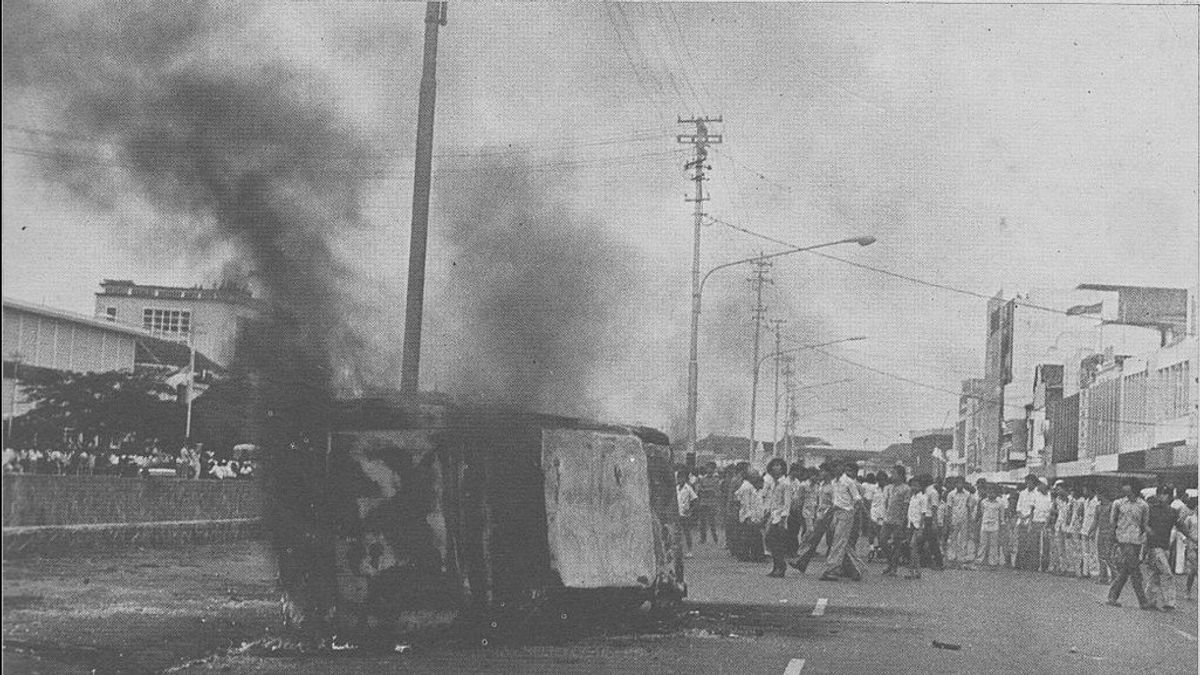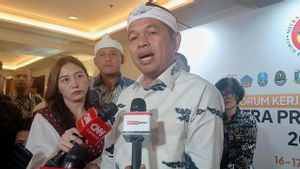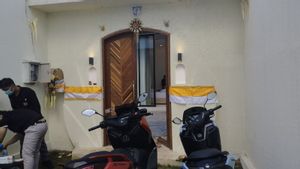JAKARTA - Today, 46 years ago, thousands of students from various campuses in Jakarta took to the streets to protest against the economic policies of the Soeharto Government which were considered too passionate about foreign investment.
Recently, the student movement was allegedly ridden by the government elite. Furthermore, this became a battlefield between the Commander of the Operation Command for Restoring Security and Order (Kopkamtib) General Soemitro and Suharto Personal Assistant Ali Moertopo.
The action known as Malapetaka January 15, 1974 (Malari) was carried out to coincide with the arrival of Japanese Prime Minister Kakuei Tanaka who wanted to meet President Soeharto. This incident was also the biggest protest action when Soeharto took the lead. This action also tarnished the face of the government in front of its own guests.
As Widiarsi Agustina wrote in the Malari Mysterious Mass: The First Political Unrest in the History of the New Order (2014), the demonstration started with the University of Indonesia Student Council led by Hariman Sirega taking to the streets. The students initially headed for Halim Perdanakusuma Airport, where Tanaka landed.
At the same time, another group called Soemitro as a mass of the Islamic Education Reform Movement (GUPPI), pedicab drivers, and Kramat thugs at the orders of Ali Moertopo's leadership, actually moved towards Pasar Senen. "Riots exploded here," wrote Agustina.
The rioting then spread to a number of places, such as Juanda Street, Gajah Mada Street, Hayam Wuruk Street, and to the Kota area. This initially peaceful action turned violent. The mobs attacked the buildings and motorized vehicles, especially those 'brought' from Japan.
The riots made fires at a number of points. The fire burned from noon to midnight. This riot burned 144 buildings, 807 cars and 187 motorbikes. Meanwhile, eleven people died, 17 were seriously injured, and 120 people were slightly injured.
Triggered by foreign investment
As reported by kompas.com, at the beginning of his administration, Suharto tried to carry out development in various aspects, one of which was paying off debts inherited from the Old Order.
One of Suharto's policies to pay off this debt was to include investments from other countries. At that time, the United States became a big partner for Indonesia, especially in the energy and mining sectors. However, the domination of Japan in Asia, especially Indonesia, was more visible at that time.
Various kinds of products ranging from transportation, electronics and consumer goods are seen being flooded with products from the Sakura country. This was what triggered the 1974 Malari incident.
The feud of the two generals
As Asvi Warman Adam wrote in his book Revealing the Mystery of History (2010), the Malari incident was described as the climax of student action that had been going on since 1973. In General Yoga Sugomo's notes - who later replaced Sutopo Juwono as Head of BAKIN (National Intelligence Coordination Agency) ) - activities on various campuses, both lectures and demonstrations that finalize the situation, ultimately lead to opposition to the government's economic policy.
These discussions were initially held at the UI Jakarta campus (13-16 August 1973) with speakers Subadio Sastrosatomo, Sjafrudin Prawiranegara, Ali Sastroamidjojo and TB Simatupang.
This was followed by the commemoration of the Youth Pledge which resulted in the "24 October Petition". The cumulation of these activities finally reached a climax when the Japanese Prime Minister Tanaka arrived, which led to the Malari incident.
By citing several book sources, Asvi explained, it seemed that Soemitro had a tendency to blame Ali Moertopo as the cause of the emergence of the student movement. Then Ali Moertopo was called "fostering" ex-DI / TII people in GUPPI (the Association of Islamic Education Improvement Efforts).
Still according to Asvi, through this organization, Ramadi and Kiai Nur from Banten were mobilizing masses who were involved in the Malari case. In addition, there is also Bambang Trisulo, who is said to have spent Rp. 30 million to pay for thugs. They were paid, among other things, to destroy Japanese cars, Toyota Astra and Coca Cola offices. This was done to damage the image of the students and beat the duo Soemitro and Soetopo Juwono, when they were still heads of BAKIN.
Meanwhile, in the document Ramadi - a close friend of Ali Moertopo - revealed Soemitro's plan to mobilize power on campuses so that finally a general with the initials S would seize power by overthrowing the President around April to June 1974.
"A social revolution will definitely erupt and Pak Harto will fall", wrote Ramadi. Ramadi is known to be close to Ali Moertopo, the accusation in the "document" of course refers to General Soemitro.
The feud between the two generals, as explained by historia.id, has been going on since 1971. In Soemitro's view, Ali had the ambition to become the Head of BAKIN. But Soemitro never agreed.
He then suggested that Ali fill the position of information minister. Suharto agreed, but Ali refused. After that Soemitro warned Ali, who, according to rumors, wanted to replace Suharto as president.
"Do not you hold machtosvorming (formation of forces) with the aim of overthrowing him (Soeharto). If that is what you do, you will face me, ”Soemitro's ultimatum told Ali as quoted by historia.id.
Meanwhile, on Ali's side, Soemitro is considered to have often acted arrogantly beyond his authority as the Head of Police and Security. Seomitro is like the prime minister or the second person who runs the government. He often summoned the ministers to the Kopkamtib office and held meetings there. In addition, Soemitro, on behalf of Soeharto, also scolded Ali about Ali's statements regarding the Sabah region.
Ultimately, Soemitro garnered sympathy for the students. The campaign was successful. Among the students his image was sticky as a reformer amid disgust with the terms "political general" and "money general" under the Aspri institute. Here Ali is the target of Soemitro's narrative. This Aspri institution was later labeled as the henchman of Japanese capitalists.
On the other hand, Soemitro seemed less sophisticated than the assistant to the President. Ali was predicted to have a higher political agenda. He is said to want to become vice president under Suharto and then replace him.
Finally, after the Malari incident, Soemitro lost. The rioting also tarnished the face of the Soeharto government in front of his state guests. And the official responsible for this was Soemitro. From there, Soemitro finally resigned as Pangkopkamtib. The position was later taken over by the president.
Apart from that, Soemitro's duet friend, Sutopo Juwono, was also removed from his position as Head of Bakin. He was sent to the Netherlands as ambassador.
At first, Ali Moertopo was seen as the winner. However, not long after, the Aspri Institute was also dissolved. Ali's influence slowly dimmed. Ali was also killed. And the real winner is still the leader of the New Order, Suharto.
The English, Chinese, Japanese, Arabic, and French versions are automatically generated by the AI. So there may still be inaccuracies in translating, please always see Indonesian as our main language. (system supported by DigitalSiber.id)









